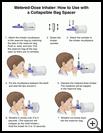
Metered-Dose Inhaler, How to Use with a Collapsible Bag Spacer
________________________________________________________________________
KEY POINTS
- A metered-dose inhaler is a hand-held device that sends a mist of medicine directly to your child’s lungs as your child takes a deep breath.
- A device called a collapsible bag spacer, or reservoir bag, can be used with the inhaler. It can help if it’s hard to press the inhaler while your child breathes in the medicine.
- Your healthcare provider or pharmacist can help you and your child learn how best to use the inhaler and spacer.
________________________________________________________________________
What is a metered-dose inhaler with a spacer?
A metered-dose inhaler (MDI) is a hand-held device that releases a mist of medicine. It contains a gas that helps the medicine get into your child’s lungs. The inhaler helps send the medicine directly to your child’s lungs as your child takes a deep breath.
A device called a collapsible bag spacer, or reservoir bag, can be used with the inhaler. It can help if it’s hard to press the inhaler while your child breathes in the medicine. The spacer holds medicine in the bag and:
- Helps your child to breathe at his own pace
- Helps more medicine to reach your child’s lungs
- Keeps medicine from just going into the air
Spacers can be used with or without a mask. Some spacers are made for just one type of inhaler. Some types of inhalers are not meant to be used with spacers.
To attach the spacer to the MDI:
- Attach the inhaler mouthpiece to the bag by matching the tabs in the bag.
- Push in, twist, and lock.
- Pull the bag all the way open so there are no wrinkles.
- Remove the inhaler canister from the plastic case and shake it well.
- Attach the canister to the inhaler mouthpiece.
To use the MDI with the spacer and a mask:
- Choose a mask that is the right size for your child (small, medium, or large) and attach it to the mouthpiece.
- Have your child stand or sit up straight.
- Put the mask against your child's face, covering both the nose and mouth. The mask must be pressed to your child's face to make sure that the medicine can get to your child's lungs.
- Depress the MDI once. The medicine will be trapped in the reservoir bag.
- Have your child breathe in slowly over 3 to 5 seconds. The reservoir will collapse as your child inhales. You will hear a whistling sound if the breath is too fast.
- Have your child hold his or her breath for 5 to 10 seconds.
- Have your child breathe out slowly back into the reservoir bag.
- Still using the bag, have your child breathe in and out slowly once or twice more.
- If your provider prescribes additional puffs, wait 1 minute and repeat.
To use the MDI with the spacer and mouthpiece:
- Put the mouthpiece between the teeth and seal the lips around it.
- Press the inhaler down once so it releases a spray of medicine into the bag spacer.
- Have your child breathe in slowly over 3 to 5 seconds. The bag will collapse as your child inhales. You will hear a whistling sound if your child’s breath is too fast.
- Have your child hold his or her breath for 5 to 10 seconds.
- Have your child breathe out slowly back into the bag spacer.
- Still using the bag, have your child breathe in and out slowly once or twice more.
- If your provider prescribes additional puffs, wait 1 minute and repeat.
If your child is taking an inhaled steroid medicine, have your child brush teeth and rinse his or her mouth with clear water after taking this medicine. The water your child rinses with should be spit out.
Cleaning the equipment:
The mouthpiece should be washed daily with warm water and dried. Do not put it in the dishwasher. The manufacturer does not recommend washing the bag spacer. The bag should be replaced when it wears out, or once every month.
Last modified: 2021-07-27
Last reviewed: 2021-06-15

